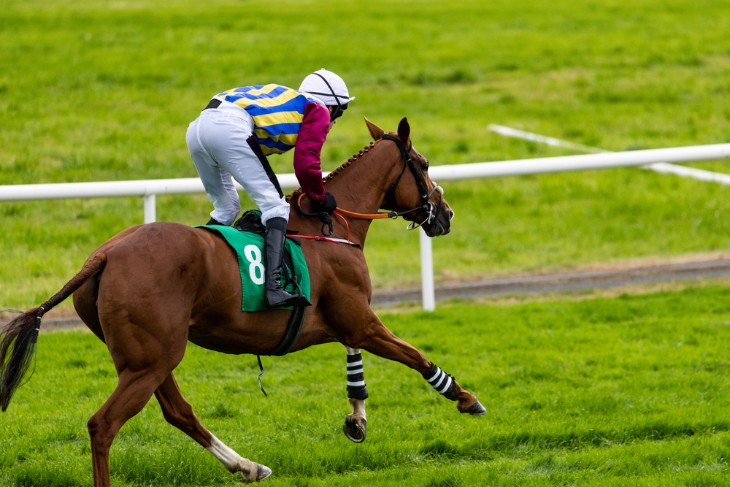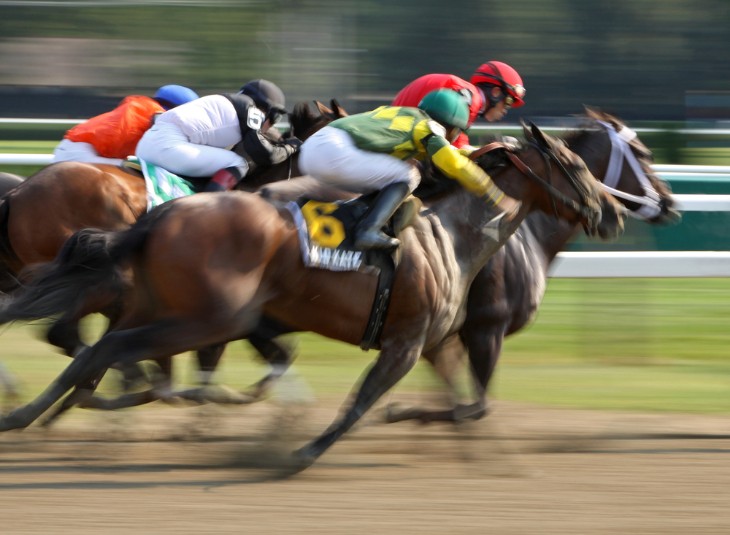Horse racing has a history and diverse conditions that add excitement for both the horses and the bettors. One key factor influencing race outcomes is the nature of the ground.
Lets delve into what "soft" ground signifies in horse racing. Understanding this distinction from "yielding" ground can shed light on how it impacts races and enhances our grasp of the sport. This explanation is designed to be straightforward for individuals in grade or higher ensuring easy comprehension.
The Significance of Ground Conditions in Horse Racing
The track conditions play a role in horse racing influencing performance, jockey strategies and race results significantly. Terms like "soft" and "yielding" commonly describe track conditions in regions such as the UK and Ireland.

What Does Soft Ground Mean in Horse Racing?
In horse racing when we mention that the track is "soft " it means that the ground is wet and squishy usually due to rain. Picture how your feet sink a little when you walk on a wet field; that's what the horses experience. They must exert effort to push off and run, which can impede their speed. It's akin to attempting to run on a beach with soft sand rather than on a solid paved path.
Soft ground impacts races in ways. Races tend to be slower because the horses can't accelerate rapidly on the mushy surface. Therefore races on ground often evaluate which horses possess good stamina—the ability to maintain strength over an extended period—rather than just their speed. Horses that can sustain their energy perform well on ground.
However not all horses enjoy running on ground. Some actually fare better because they gain traction and maintain balance effectively. Conversely others struggle since it demands exertion potentially affecting their performance in races. This underscores the importance for trainers and jockeys—the people responsible, for training and riding the horses—to understand their horses preference regarding the type of ground they thrive on.
Bettors consider the ground condition when selecting horses for racing and strategizing for victory.
Those who place bets on races also take into account the ground factor. Recognizing which horses excel on terrain can assist in making wiser betting choices. Having this knowledge is crucial for both winning bets and gaining an understanding of the sport.
Impact of Soft Ground on Horse Performance
The soft ground significantly impacts how horses perform in races altering their running style and swaying race outcomes. Lets delve into the effects of ground on horse performance:
- Slower Race Times: Horses face limitations in speed on soft ground as their hooves sink deeper hindering swift movement. Consequently race times tend to be slower compared to those on tracks.
- Increased Effort: Horses exert effort when racing on soft ground akin to running in deep sand necessitating increased energy expenditure with each stride. This added exertion can prove draining, during longer races.
- Different Winner Profiles: Certain horses thrive under ground conditions due, to their enhanced stamina and ability to cope with the additional demands placed upon them.
On the side horses that excel in speed on solid surfaces may face challenges when racing on softer tracks. - Strategy Changes: Jockeys could alter their tactics when racing on ground. They might opt for a start to conserve energy or navigate the track differently to locate firmer footing.
- Training Adjustments: Trainers prepare horses differently for races held on soft ground. Their focus shifts towards enhancing stamina and strength aiding the horses in handling the demanding conditions
- Health and Safety: Racing under ground conditions can be strenuous on a horses limbs and joints. Trainers and veterinarians closely monitor the horses to ensure their well being and prevent injuries.
Yielding Ground vs. Soft Ground: Understanding the Difference
Although "soft ground" is an used term in the UK and Ireland "yielding ground" is also prevalent. It's crucial to comprehend the nuances between these terms for making choices in horse racing.
Characteristics of Yielding Ground
Yielding ground differs significantly from firm terrain in horse racing, occupying a middle ground with its distinct characteristics. Here's what sets yielding ground:
- Moderate Moisture: Yielding ground retains some moisture but isn't as saturated, as soft terrain.
The ground is slightly damp providing some cushioning while maintaining a degree of firmness. This balance influences how horses perform on it. - Faster than Soft, Slower than Firm: Races held on yielding ground tend to be faster than those on ground but slower than on firm ground. The moisture content allows horses to move freely compared to deep soft conditions though not as swiftly as they would on hard dry tracks.
- Variable Impact on Horses: Some find it ideal due to its nature particularly if they struggle with extreme firm or soft conditions. Others may find it challenging if they prefer one end of the spectrum.
- Affects Strategy and Training: Trainers and jockeys must take into account the characteristics of yielding ground when preparing for races. They may train horses to adapt to this middle ground surface or adjust their racing tactics accordingly.
- Weather-Dependent: The condition of yielding ground can shift rapidly based on weather conditions. A bit more rain can turn it into ground while a sunny day can make it firmer. This variability has implications for decision making, on race days.
How Horses React to Yielding Ground
In the world of horse racing "yielding ground" refers to a track that's not as soaked as "soft ground" but still retains some moisture resulting in a slightly yielding texture. It falls somewhere in between. Not excessively firm yet not overly soft either. This type of track can be tricky to navigate due to its bounce though its not overly soggy.
Horses generally find it more manageable to race on yielding ground compared to soft terrain. They do not have to struggle with pulling their hooves out of mud allowing them to maintain a faster pace. Despite the give in the ground there remains a level of softness that is beneficial for their legs providing some cushioning and reducing the risk of injury.
Individual horses have varying preferences when it comes to types of terrain. Some horses that struggle on soft tracks may perform better on yielding ground because it offers a balance that suits them well without causing excessive strain. On the hand horses that thrive on hard tracks may not favor yielding ground as much due, to its slightly softer nature.
For individuals involved in caring for and riding horses understanding the type of terrain that suits a horse can have an impact. If they are aware that their horse performs well on yielding ground they may opt for races held on tracks. It is also beneficial to train horses to acclimate to track conditions, which could prove quite useful.
Those who engage in horse racing betting also need to take the track surface into consideration. A horse that excels on ground may not be the wisest choice for a race on yielding ground and vice versa. Studying race performances of horses can assist bettors in determining where to place their bets.
Thus yielding ground represents a track condition that can influence the outcome of a race. The preference of a horse for this type of terrain can impact its performance allowing everyone involved to make informed decisions.
For more information on horse racing betting - click here: Best Horse Racing Betting Sites.
Strategies for Racing on Soft and Yielding Ground
Strategies employed during races significantly vary based on the condition of the ground. Jockeys and trainers must adjust their techniques accordingly, according to the state of the track during race day.

Tactics for Soft Ground Races
Competing on soft ground necessitates strategies tailored for jockeys and trainers.
The nature of the track affects how races unfold and who emerges victorious. Here are some strategies commonly employed in races held on ground:
- Focus on Stamina: Endurance plays a role in races conducted on soft ground. Horses must sustain their effort when the track demands more from them. Trainers focus on building horses stamina while jockeys strategically manage the race to conserve energy.
- Choosing the Right Path: Jockeys seek out the favorable route on the course. Certain sections of the track may provide traction due to less softness. Sticking to these paths can significantly impact race outcomes.
- Adjusting Speed: Effective speed control is essential in conditions. Racing fast early on can exhaust a horse quickly on soft ground. Jockeys often begin at a pace and adjust speed based on their horses response as the race progresses.
- Horse Selection: Not all horses excel in soft conditions. Trainers opt for horses, with proven ability to handle tracks considering past performances when entering races.
- Careful Warming Up: Pre race warm ups are tailored accordingly. Horses must be prepared to perform on surfaces without expending excess energy beforehand.
- Weather Watch: Weather conditions can shift suddenly impacting the racecourse. Jockeys and trainers monitor the weather closely. May adjust their strategies if the track conditions change.
Preparing Horses for Soft Ground
One of the tasks for trainers is getting horses ready to race on soft yielding ground. Racing under these conditions requires effort so special preparations are essential.
To start off, trainers focus on ensuring that the horse can maintain endurance over a period. Endurance is crucial as the horse needs to exert energy on soft ground. Trainers may increase the horses running distance. Incorporate additional stamina building exercises into their daily regimen.
Strength is also vital. Horses require muscles to perform well on soft ground. Running uphill is a method used to strengthen muscles particularly in their hind legs, which enhances their overall strength and performance during races on softer surfaces.
Furthermore, acclimating the horse to the sensation of ground beneath its hooves is critical. Trainers seek out areas with terrain, for practice sessions so that the horse is not caught off guard on race day.
Being confident and steady on surfaces can significantly impact their performance in races.
Maintaining a diet and staying in good health are equally crucial. Horses require nutrition to develop muscles and sustain energy levels especially when navigating challenging racetracks. Routine check ups by the veterinarian ensure the horse remains in condition.
Additionally it's essential to prioritize the horses well being. Trainers invest time in preparing their horses for races. A calm and focused horse performs better under demanding racing conditions.
The Role of Track Maintenance in Ground Conditions
Track maintenance plays a vital role in managing ground conditions. Dedicated racecourse personnel work diligently to ensure that the track is well prepared taking into account weather variations and safety considerations.
Techniques Used in Track Maintenance
Maintaining quality on horse racing tracks is paramount. Track maintenance teams utilize techniques to uphold safe and equitable conditions for all horses. Below are some approaches used in track upkeep:
- Watering the Track: This practice prevents the ground from hardening particularly during dry spells. Adequate watering helps create a surface, for the horses reducing the likelihood of injuries.
- Aeration: Aeration, which entails creating holes in the track to improve air and water circulation is crucial for preventing compaction and preserving the tracks quality.
- Rolling: Rolling helps out the track surface by compacting the soil top layer ensuring consistency for both horse safety and fair races.
- Harrowing: Harrowing is used post aeration to smooth out the track surface enhancing safety and race quality.
- Monitoring Ground Conditions: Constant monitoring of ground conditions by track staff using tools helps determine necessary maintenance actions to uphold optimal track conditions.
- Adapting to Weather: Weather plays a role in influencing track conditions prompting maintenance teams to adjust their strategies accordingly by increasing watering during hot dry spells or conducting additional aeration if the ground becomes too hard.
Impact of Weather on Track Conditions
The impact of weather, on horse racing tracks cannot be underestimated as it directly affects race outcomes and overall track performance.
The condition of the track can vary depending on the weather, which in turn affects how races unfold.
When it rains tracks can become soft or even muddy. The rain causes the ground to become soggy requiring horses to exert effort when running. The muddier it gets the harder they have to work resulting in races and potentially altering the outcome for certain horses.
On dry days the track can become firm or hard. Dry tracks are faster as they are more compacted allowing horses to move swiftly across them. Horses that thrive on tracks excel in these conditions showcasing their speed and agility.
However excessive sunlight and dryness can pose challenges too. When the track becomes too hard it can impact the horses legs adversely. Proper maintenance of the track is crucial during conditions. Racecourse caretakers may water the track to ensure its quality for racing and maintain fairness for all participating horses.
The unpredictable nature of weather changes poses a challenge, for trainers and individuals placing bets on races.
On a sunny day, a horse race might turn into a wet and muddy affair if unexpected rain showers make an appearance. Trainers need to be mindful of this possibility when selecting the races to participate in. For those placing bets staying informed about the weather forecast can lead to wiser decisions.
The weather plays a role in horse racing outcomes. Rain can transform tracks into muddy surfaces while sunshine can result in fast and firm conditions. These factors influence race dynamics and impact which horsesre likely to perform well. Both trainers and bettors must closely monitor the weather for success in the world of horse racing.
Conclusion
In essence - comprehending the intricacies of yielding terrains in horse racing is essential for all individuals engaged in the sport. Whether you're a betting enthusiast, trainer, jockey or simply an admirer of the sport - recognizing how ground conditions affect races can deepen your enjoyment and insight into this exhilarating pursuit.
By taking into account variables such as horse preferences, race tactics and track upkeep practices, you can develop an understanding of what makes horse racing on various terrains so captivatingly unpredictable.
For more information:







